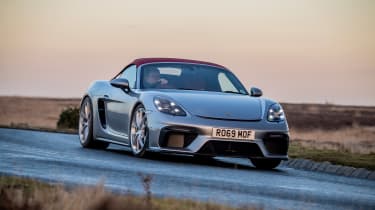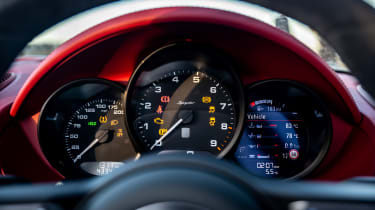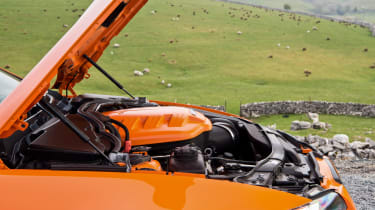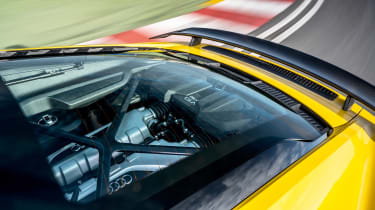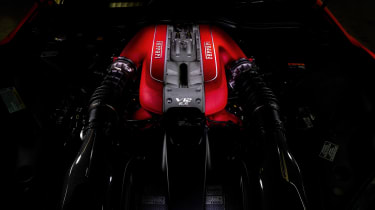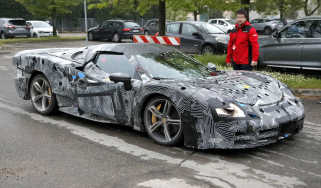Naturally aspirated engines – best of the breed from 4-pots to V12s
The naturally aspirated engine is capable of stirring emotions a turbocharged motor can only dream of. We celebrate the best of the breed.
Time changes everything. Forty years ago, the excitement and novelty factor of the turbocharger was enough to prompt the contrivance of the word being plastered on everything from vacuum cleaners to razor blades. Natural aspiration? Oh yes, that more traditional approach, where air enters the induction system of an internal combustion engine at the same pressure as the planet outside before being compressed with a squirt of fuel by the piston and ignited with the assistance of a spark? That one was suddenly so very yesterday.
Nevertheless, and perhaps against the odds, the naturally aspirated engine mounted a comeback, and for a while the turbocharger was as unfashionable as other forms of ’80s excess, such as Ferrari Testarossas and shoulder pads, and those weird battery-powered dancing flowers in pots. The naturally aspirated engine made inroads back into both motorsport and road cars, from Formula 1 to hot hatchbacks. Revs and noise were once again king.
It didn’t last, though, and in more recent years the roles have been reversed again – for well-documented reasons ranging from emissions testing to the growth in vehicle weight and the subsequent need for strong, low-down torque – and we now have a situation where the naturally aspirated engine is a real novelty, and the introduction of a new one – as in the Cayman GT4’s 4-litre flat-six – an almost unthinkable and celebratory extravagance.
But apart from desiring what we can no longer have, the lure of the NA engine is obvious. However advanced turbocharging set-ups become, they can never hope to replicate the direct and instantaneous relationship between the movement of your right foot and the response of the throttle, and their use of exhaust gases to force-feed an engine with air above atmospheric pressure means an inevitable masking of intake and exhaust noise.
Here, then, we look at the great and the good of naturally aspirated engines, and a few duff ones too, and try to explain just what makes them so desirable.
Four-cylinder
Just the very ubiquity of the naturally aspirated four-cylinder engine gives it a bad press. It’s humdrum. Workmanlike. Unglamorous. It tends to make simply a duh noise, a dreary one-dimensional timbre, and while it’s hard to pinpoint exactly why that’s dull, our ears tell our subconscious it most definitely is. At its worst, a mass-produced four-cylinder engine is unenthusiastic, coarse, and just unpleasant. Joyless, frankly.
The four-stroke four-cylinder will never be as smooth as, say, a straight-six, due to the among other things its lack of overlapping power strokes per crankshaft revolution. But of course, we’re not going to talk about humdrum four-cylinder engines here, we’re talking about performance versions, and of those there have been many. Sadly, they are virtually non-existent now. The Mk4 Mazda MX-5’s has improved and is now quite a free-spirited thing, the Toyota GT86/Subaru BRZ’s flat-four is still a coarse and rather gutless companion, and there are still low-volume sports cars such as Caterhams that use off-the-shelf engines such as the Ford Duratec. Essentially, though, that’s about it.
What a pity that is, because depending on your age you’ll no doubt have great memories of simple but oh-so-special four-bangers. Rorty, whiny old A-series-powered Minis, screaming Ford BDAs reverberating through forests in Mk2 Escort rally cars, gutsy early ’80s hot hatches with eight-valve motors such as the VW Golf and Peugeot 205 GTI, or the newer-age 16-valve crowd, which seemed so potent when 150bhp was breached, from the Astra GTE to the Peugeot 306 GTi 6. Then, of course, there was Renault, with the F-series engines stretching from the Clio 16v and Williams all the way to the last non-turbo Clio 200. But perhaps as we reminisce, we think of the extremes most fondly, and inevitably that leads us to Honda’s VTEC engines.
VTEC was, and still is, a way of adjusting an engine’s valve timing to suit either low-speed economy or high-rev power. It features two sets of cam lobes: the milder-profile ones for the everyday, and a much more aggressive set that allows the engine to keep the valves open for much longer for enthusiastic driving. At a predetermined point in the rev range the hotter cams are engaged via a hydraulic mechanism that shifts them into contact. Ingenious. And at its most memorable, capable of creating something instantly forgettable and mild-mannered one moment, and as feisty, free-revving and hard-edged as a touring car motor the next.
It’s this willingness to rev high, and with a lack of vibration and harshness that suggests the engine is enjoying every minute of it, that makes VTEC so special. It hasn’t always made the car faster on-road than rivals (on track is a different matter), because falling out of the VTEC zone through an unexpectedly tight corner or poor gear choice was bad news, and an issue not shared by something such as a Clio Williams. But when the rev counter needle flies past 8000rpm like it does in an EP3 Civic Type R, to be honest, it’s completely captivating, and worth the price of buying one alone.
Six-cylinder
Jumping to six-pots changes everything. The addition of two extra cylinders brings with it not just a perception of prestige, but a depth and breadth to a car’s voice, overlapping power pulses, as well as benefits to its performance. Unusually, three different layouts of the six-cylinder engine remain in favour: the straight-six, the V6 and the flat-six.
It’s the V6 that’s enjoyed the greatest popularity in recent years, and when turbocharged that often makes for a very capable engine. But if we remove the blowers for a second, the picture is a lot less clear. When a V6 is good, it can be very good: think Honda’s original NSX with VTEC relish supplied, Alfa Romeo’s Busso engine or the wonderful Ferrari Dino V6 from the 246GT and Lancia Stratos.
When it’s bad though… it can be a gritty, painful-on-the-ear misery. Think ‘cheap American hire car’, the one that makes you wince when you decide to beast it straight out of the airport car park. The typical 90-degree V6 is not balanced in the way a straight-six is, effectively being a pair of in-line three-cylinder engines joined together. Popular because the typically compact dimensions of the engine make it easy to package, even in front-wheel-drive cars, it requires balancer shafts to make it acceptably smooth.
The straight-six usually has no such problems, because its primary and secondary forces are in balance; the pistons at the front and towards the rear of the engine move in effectively a mirror of each other. This really is the most noble of engine layouts, forming the basis of British sports cars for many years, in the Jaguar XK and Aston Martins, plus more latterly the charismatic but flawed TVR Speed Six, and is of course synonymous with cars from the German city of Munich. When those M-cars have been naturally aspirated they’ve been things of wonder, from the original M88 3.8-litre M1 engine through to the unforgettable S54, which, particularly in E46 CSL trim, has arguably the best induction noise of any car, ever. BMW now turbocharges its straight-sixes, and while ferocious in their torque delivery, they have nothing like the charm of the old NA engines.
Which leaves us with the flat-six, and we don’t have to go far down the A8 autobahn to find the greatest exponent of this format. Nicely balanced, compact, and with a low centre of gravity, Porsche has elevated the naturally aspirated iteration of this layout to a fine art. Indeed, whether humble 986 Boxster or 991.2 GT3 RS, that smooth, rev-happy flat-six is the perfect partner to the excellence of the car’s dynamics. It’s why the company clings on to making them, seeking ever more power out of them and at revolutions per minute that would once have been unthinkable. When it does surrender to legislative pressure, as in the 718, we all moan furiously, as if our own grandmothers have been personally insulted by CEO Oliver Blume, and demand Weissach sorts it out. That it can, for now, with engines such as the new GT4 and GTS motor, is something to be very thankful for.
Eight-cylinder
Everyone loves a V8, don’t they? From the soporific, mellifluous woofle of a lazy American V8 to the demented howl of something high-revving and usually Italian, a naturally aspirated V8, free from the dampening shackles of forced induction, is a thing of beauty. It’s also now exceptionally rare, outside of muscle cars, old Maseratis and the unlikely, slightly weird, but still intriguing performance offerings from Lexus.
The dichotomy of the NA V8 centres on the layout of its crankshaft, particularly the angle between the crank pins, or ‘journals’ – the cylindrical passages between the lobes where the big ends of the conrods are attached. Put those at 90 degrees to each other and you have a cross-plane crank V8; have them at 180 degrees and, as the angle implies, you have a flat-plane crank style of engine. The former has unevenly spaced firing patterns, and it’s this, along with the manifold and exhaust design, that gives the traditional V8 sound – think the aforementioned muscle cars, and the ubiquitous Rover V8, etc.
The flat-plane crank V8 is more like two in-line fours joined together in its operation, and its even firing order gives it a completely different sound, along with a propensity to be more suited to higher revs – as you’ll find in a Ferrari 458 Speciale, for example.
Both types have differing challenges when it comes to balancing the forces generated within, and without turning this into an engineering textbook, the cross plane needs heavier crankshaft counterweights to negate its rocking motion, but on the move it’s inherently much smoother than the flat-plane unit as each bank cancels out the secondary forces of the piston strokes. That’s why you’d never find a buzzy, hard-timbred Ferrari V8 in a luxury car, or if you did, as in the case of Maserati or going right back to the 328’s engine in the Fiat Thema 8.32, it’s been reworked to have a cross-plane crank, along with, inevitably, a lower rev limit.
Of course, there are always the exceptions to the rule. The current Mustang GT350 is a true blue muscle car with a flat-plane V8, and the old E90/92/93 M3s revved to blazes but had a cross-plane V8; the firing order of the cylinders in the M division’s S65 masterpiece gave it a different sound again to the typical American V8 rumble, a smoother, lighter, more sonorous blare, but still with the bass notes amplified. The E92 M3 GTS is a perfect case in point.
Before the photoshoot for this feature it had been a while since I’d last driven a GTS, and in truth I’d forgotten just how appealing the S65B44 engine (the suffix denoting the GTS’s extra 362cc over the standard 4-litre S65B40 unit in the regular M3) really is. We live now in an era when the overriding emotion is simply gratitude that internal combustion-powered performance cars exist at all, along with a nagging sense of trepidation that time has already been called on the party. As such, a turbocharged V8, usually backed by a manufacturer claiming ever more outrageous power and torque figures, feels like something it would be sacrilegious to moan about. We do just that, of course, on this magazine, and I sometimes think there must be those who wonder what we’re constantly banging on about, or that we’re merely a group of grumpy, ageing men, always looking over our shoulders. But the uncomfortable truth is that just a few seconds back behind the wheel of a car powered by the S65 shows it is enough to quash anything that BMW M currently makes. The S63 twin-turbo found in the current M5 for example, and derived from the regular N63 turbo V8, has nothing on this old-timer in terms of appeal. But what do we actually mean by that?
I think it’s something to do with that word that’s key across so many areas of a great car: connection. If you appreciate how an engine works, revel in its operation, get a kick out of the rawness of sound that comes with each meticulously timed explosion happening within, love the excitement and controlled aggression – even artistry – of driving for enjoyment, then you can connect with a great NA V8 on an emotive level. It goes beyond merely operating a device to make an inanimate object move very quickly. It’s why some of the best memories I will take away from our old Fast Fleet Mustang are of driving it slowly, letting the engine haul from low rpm, during which it felt as though each individual ignition at top-dead centre could be felt: thud, thud, thud, thud.
That is very relaxing, in a therapeutic kind of way, which is not something you could say about the Dino V8 in a Ferrari 360 Challenge Stradale, or the last-of-the-line F136 V8 in the aforementioned Speciale. Their raw, rabid intensity, the intimidating sharpness and precision of their throttle response, and the agitated howl that emanates from their tailpipes – and that makes those of us who love cars feel all a bit peculiar – is the very essence of the operatic Italian supercar experience. It just conjures up highly strung beauty, passion, speed and spirit. That’s why however fast the 488 Pista, or its successors, they’ll never quite eclipse the vibrant Speciale.
Ten-cylinder
Bar oddities such as the Dodge Viper, the V10 layout in road cars has been a more recent phenomenon. Much of the inspiration for this trend came from motorsport, and specifically F1, when it returned to naturally aspirated engines for the 1989 season. Most teams took the traditional Ford Cosworth V8 route, and Ferrari automatically reverted to its classic V12 configuration, but Renault and Honda opted for the V10, figuring it offered the best compromise between the V8’s meaty midrange and the V12’s high-rev exuberance, but without the latter’s added weight, thirst and frictional losses. Strangely, Honda would switch to V12 power for 1991, but soon all manufacturers settled on the V10 configuration, which held sway until the rules changed and demanded small-capacity V8s from 2006.
The Porsche Carrera GT’s piercingly intense V10 started life as a racing engine for a Le Mans contender that never was, and it’s doubtful BMW would have pursued its wonderful – and wonderfully inappropriate in many ways – naturally aspirated V10 for the E60 M5 (and E63 M6) had it not been for the leverage of its noughties F1 programme, nor Lexus the LFA’s stellar V10 without Toyota’s largely ill-fated F1 era.
Yet the brands most associated with the type must surely be VW group bedfellows Audi and Lamborghini, who have made the big V10 a cornerstone of their respective supercars, starting with the original Gallardo back in 2004. At birth, the Lambo-developed unit displaced 5 litres and made 493bhp, instantly setting the car apart from its Maranello opposition purely by offering such a uniquely appealing character. Flexible, punchy, but with an exuberant top end, it truly was a thumping Bologna heart.
Its 5.2-litre successor was an Audi engine, which would go into the R8 as well as the Gallardo facelift, the LP560-4 (and the S6 and RS6 of period), and survives in updated form in the Mk2 R8 and Huracán Evo models. The spacing between the cylinders is greater, there’s direct fuel injection, and while it remains a 90-degree V, it has an uneven firing order with shared crankpins, which gives it a more guttural note, with less of the typical V10 wail; it sounds more like a classic five-cylinder Quattro motor in stereo gorgeousness.
Whichever generation, the V10 is larger than life, and while the R8 and later Huracán have begun to lag behind rivals from the likes of McLaren in other technical areas, the V10-powered machines usually end up maintaining their relevance purely on their ability to generate such an emotive response from a driving enthusiast.
Twelve-cylinder
The big, naturally aspirated V12 remains the true thoroughbred of engines. It follows that two straight-sixes joined together will be exceptionally smooth, while small pistons keen to rev and ornate exhaust manifolds usually guarantee a sonic experience as special as the power delivery and numbers. But there’s more, so much more: a certain majesty, an extravagance verging on rudeness, an opulence that, nowadays in particular, feels so special. Ferrari and Lamborghini recognise this, which is why they push materials and technology to the limit to not only unleash increasingly ludicrous levels of power and torque, but to keep their engines within increasingly stringent emissions laws. That won’t always be possible, but these fabulous dinosaurs will be the last to bow to extinction because those companies know that their well-heeled customers actively choose these cars for the quality, theatre and emotion of a naturally aspirated V12. When changes are inevitable, expect some form of electric intervention before there’s even a mention of a turbocharger.
For all a Lambo’s blood and thunder, no one makes a V12 quite like Ferrari. The way the 812 Superfast’s enormous 6.5-litre V12 gains revs in the upper reaches of its operating range is more akin to a 1-litre superbike engine – it just has to be experienced to be believed, and even then the thought of all those components rotating and reciprocating in micro-millimetre precision, at immense speeds, time after time, simply makes the head spin. And then there’s the noise – that yowl, constantly evolving in texture in a way that a turbocharged engines never could, the use of the throttle often like playing a musical instrument. This is the stuff of supercar dreams, the unobtainable thrill.
It’s also the reason why potentially the two ultimate cars of our age, the Aston Martin Valkyrie and Gordon Murray Automotive T.50, both use bespoke naturally aspirated V12s from Cosworth with startlingly high rev limits and surely a blood-curdling shriek. They promise to be almost primeval in the awe-inducing experience they recreate, and their designers Adrian Newey and Murray – two of the most influential automotive engineers of the last 50 years – recognise that to achieve this only a V12 will do, and a naturally aspirated one at that.


